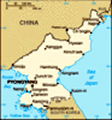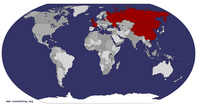Advertisement
Published: November 24th 2010
One thing they don’t like to give you whilst in North Korea is free-time. Free-time breeds curiosity and in North Korea curiosity can land you in a lot of trouble. After scoffing down a breakfast consisting of New Zealand Anchor butter and my first toast in a year, we were immediately on our way. Our guide Ms. Lee (one of four family names that make up 95% of the North Korean population), who had yet to crack a smile and Mr. Jang our guard, who seemed far more laid back, stuck to us like a wasp on jam.
As there were only my wife and I in our tour ‘group’, we would be joining up with a larger Chinese group. No matter what your nationality is, all tour itineraries include the same attractions. The only difference with the more trusted Chinese is they are allowed to stay in a city centre hotel, rather than an island in the middle of a river.
Waiting for the Chinese contingent, I was able to observe the city skyline in the hazy, early morning sun. Towering in the distance, the pyramidal Ryugyong Hotel looms above everything else. At 105 floors it will be
the second tallest hotel in the world when completed. Work on the Ryugyong Hotel started in 1987, but came to a halt in 1992 when the country ran out of money and faced a demoralising famine. Work has re-started again on what some call ‘the worlds most expensive ruin’ and ‘the hotel of doom’, with the hope of it being completed in 2012 to coincide with The Great Leader’s 100th birthday celebrations.
In the foreground workers in their drab, colourless Communist attire walked towards their offices. Expressionless children walked to school. Soldiers with guns placed haphazardly against their bags waited for buses to take them onwards to their destination. Although informed by Mr. Jang that the legal age to join the military was nineteen, many soldiers on view looked as though they had only recently finished breast-feeding.
It’s obvious what a threat Westerners are still deemed to be. Whilst the fifteen Chinese tourists shared two guides between them, my wife and I had a guard and a guide just for us. Attempting to talk to any inhabitants on our own accord can be classed as an act of espionage and lead to imprisonment no matter how innocent this
may be. Whether this is actually true, or similar to the, “if you pee in the swimming pool, the water turns pink,” yarn you’re told as a youngster, it certainly works. Without the interaction, it stops the dilution of their culture and ideologies, while at the same time keeping their suspicions of foreigners heightened.
Our tour bus was soon racing on our way along Pyongyang’s quiet roads to our first destination, the International Friendship Museum near Mt. Myohyangsan. This was a good ninety minute drive out of the capital. Flags bearing the country’s and Workers Party’s emblems were out in full force in preparations for the ruling party’s 65th anniversary. With no advertising anywhere, the only posters were those full of propaganda.
Starvation. Malnutrition. Chronic food shortages. Such hardships faced by normal North Koreans seem a regular occurrence if you believe any of the articles written about the Hermit Kingdom. Driving through the ‘show’ streets of Pyongyang, it’s hard to validate any of these claims. Immaculately presented shops with shelves full of commodities, although of minimal variety, lead you to believe in a prosperous existence. As workers hand-scrubbed the pavements, it made me wonder how many of the
inhabitants shop in these outlets and are able to buy the bulky TV’s on show.
Driving away from the city centre, rural life appeared from nowhere. Paddy fields full of farmers harvested their rice crops. Small towns of varying grandeur came and went. Some looked like recently built ‘model’ villages. Others were far more rustic and traditional. Along the empty roads, workers filled in potholes one by one by hand and trimmed the median hedges with scissors. For the small number of vehicles in North Korea, there seemed to be a ridiculous number of breakdowns, mostly communist-era built military vehicles.
Hugging the river for the majority of the journey, elderly men waded across the waist-high river with bicycles carrying a variety of products: tires, straw, people. Two women looked like they were digging a shallow grave for a deceased male relative, whose lifeless corpse was lying next to them. After seeing several similar images further along the river, I realised they were groups of workers hand-harvesting the river’s silt for construction projects. The original ‘corpse’ was jut a worker taking a well-earned rest. Some workers had waded into the river up to their waists to obtain the silt,
obviously not scared by the chances of catching hypothermia.
The International Friendship Museum was built to hold all the gifts donated to the country’s ‘Great’ and ‘Dear’ leaders from people throughout the world. Currently it contains over 26,000 gifts, protected by Kalashnikov-wielding soldiers. Ms. Lee proudly proclaimed it would take eighteen months to see them all if you spent one minute viewing each gift. Using my high school mathematic skills, I realised this should have been eighteen days, a mistake bluntly rejected by Ms. Lee as an idiotic mistake on my part.
A museum full of lavish gifts might not tickle everyone’s appetite, but there are plenty of hidden messages underneath the surface of such an attraction. For the visiting North Koreans, it shows them that their leaders believe even personal gifts should be there for the entire population to enjoy, not selfishly taken for personal gain. It also shows local inhabitants the love and respect their country garners from nations worldwide.
After the death of their ‘Great Leader’ Kim Il Sung in 1994, China presented a life-size wax statue of him to North Korea as a sign of their condolences. A waxwork Madame Tussauds would be
proud of, this gift has been given its own room inside the International Friendship Museum, where all visitors have to bow before his greatness. It was at this point that I learnt holding your hands behind your back is deemed an insult rather than a sign of respect in North Korea. A watching attendant angrily slapped my hands apart to a chorus of disapproving looks from a group of school children.
After visiting a temple and attempting to eat a nine-dish lunch we set back towards Pyongyang, passing regular military blocks. Whilst we sped through them unchallenged, locals waited to have their papers checked, unable to move freely from place to place without official approval.
The next stop on our action-packed itinerary was one of the Pyongyang’s two children’s palaces. Under the leadership of ‘The Great Leader’ these were built to allow children to practice a range of extra-curricular activities for free, from needlework to accordion playing. As we were led around the classrooms, the children smiled at us like little mechanical robots. “Every day 5,000 students come here and learn for free,” Ms. Lee chirped, again trying to impress us with large numbers. There was no doubting
the enormity of this ‘palace’, but if there were really 5,000 learning students behind the many closed doors, they were certainly the quietest and most well-behaved children I’ve ever had the pleasure of venturing near. Before leaving we were treated to an ‘impromptu’ theatrical performance of music, singing, acting and gymnastics. So professional was the performance, it was hard to believe that they only practiced after school.
For most people the highlight of any trip to North Korea is the chance to see the Arirang Games, the largest choreographed gymnastic performance in the world, performed by over 100,000 gymnasts, artists and children. The games are the perfect opportunity to show off the states ideology; “the subordination of the individual’s desires for the needs of the collectives,” and allow spectators to marvel at the complex levels of teamwork. The performance highlights North Korea‘s rich, powerful history, their successes and future possibilities. Before we ventured to Pyongyang May Day stadium, the biggest stadium in the world with a 150,000 capacity to see the Arirang Games, there was still time to see ‘The Great Leader’s’ birthplace, located on the edge of the city near a rusting amusement park.
After leaving his
home on the outskirts of Pyongyang, in 1925 at the age of thirteen, Kim Il Sung didn’t return home until twelve years later, after he led the Koreans to victory over the Japanese. Quite an impressive fete for a twenty-five year old, and a fete far more imaginative than truth. Like a lot of Korean history, changes have been made to create the personality cults of the nation’s leaders, keeping them at unparalleled levels of positive public opinion.
In the recently restored dwelling where he was born, lay the straw mat he slept on after returning home victorious. This sixty year old straw mat has remarkably stood up to the test of time. Seeing a fabricated heirloom, alongside doctored photos and an invented history, you wonder what if anything of this attraction was in fact true. As I pondered this, North Koreans frantically fought over each other to drink water from the ‘Great Leader’s’ childhood well.
Finally, it was time for the Arirang Games. With hunger cravings satisfied with a plate of traditional Pyongyang cold noodles, we found our seats and waited for the performance to begin. Railings and attending soldiers separated us from the local spectators. Opposite
us sat 18,000 children. These children would act as the backdrop, producing mosaic after mosaic of tiny coloured squares. As they held up a mosaic of the ‘Great Leader’ himself, the local spectators applauded with deafening ferocity.
The professionalism of the performance was immense. Considering that each routine contained thousands upon thousands of performers, to complete the ninety minute show without a single mistake, pushes the boundaries of human endeavour to its limits. North Korea doesn’t do things by halves, and this play was no different. It’s hard not to marvel at its ingenuity and leave believing that the Juche philosophy that the country follows; of self-reliance and teamwork does have the ability to create a powerful, successful nation. But then again this record-breaking performance was produced for this sole reason.
As I mulled over the evening’s entertainment it dawned on me that I had yet to come in to contact with a woman who was not blessed with the looks of an angel. I asked our guide Ms. Lee, what all the ugly girls do for work as I had yet to meet one, to which I received a giggle, a smile and a shrug in response.
With the constant PMT frowns now broken, maybe Ms. Lee was starting to warm to us.
Advertisement
Tot: 0.196s; Tpl: 0.017s; cc: 24; qc: 92; dbt: 0.1134s; 1; m:domysql w:travelblog (10.17.0.13); sld: 1;
; mem: 1.4mb























Cessna152
Jason Smart
A fascinating account of your visit to this oddity of a nation. One day, I hope to get to North Korea too.